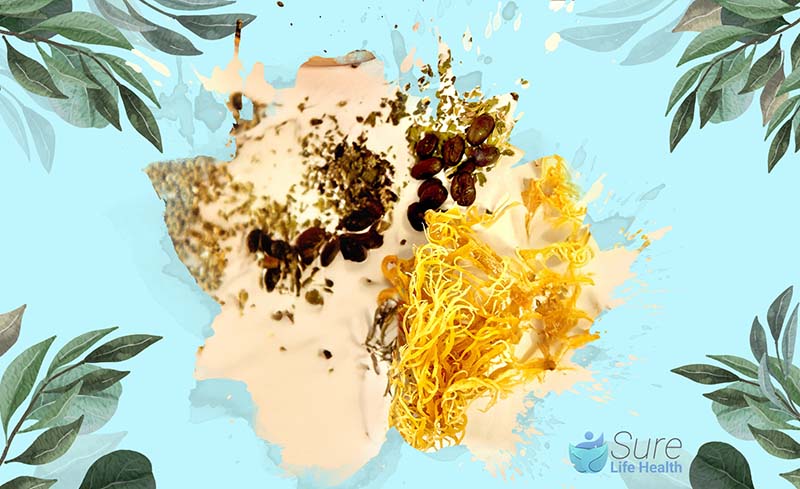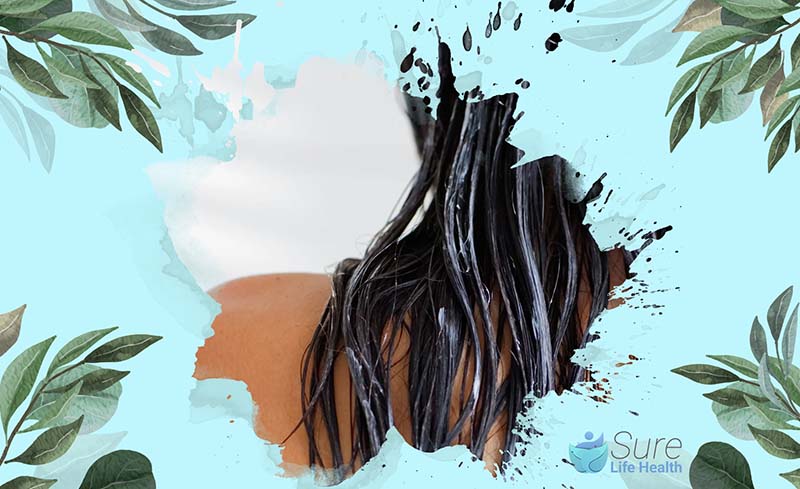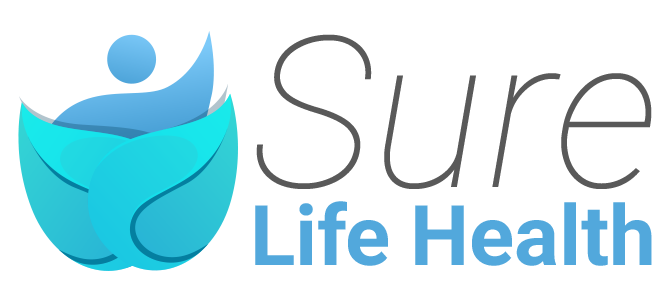Sea moss has long been a cherished natural remedy, utilized for centuries not only to enhance skin health but also to boost hair vitality. It’s common to spot this marine gem in the ingredient lists of various hair care products, or even as a nutritious addition to smoothies.
If you’re beginning your journey towards better hair care, you might be curious, “Is sea moss good for hair?” Rich in essential nutrients, sea moss is acclaimed for its ability to hydrate and fortify hair, promoting robust and healthy growth.
This guide aims to unfold the wonders of sea moss for your hair. Explore its hydrating powers and strength-enhancing qualities with Sure Life Health to help you make an informed decision about incorporating it into your hair care regime.
Is Sea Moss Good for Hair?
Sea moss is often celebrated by those who have noticed improvements in hair growth after incorporating it into their routine. While individual results vary and cannot be guaranteed due to differing body chemistries, there is emerging research that supports sea moss’s potential to activate hair follicles and promote hair growth.
Packed with Omega-3 fatty acids, zinc, fucoidan, and folic acids, sea moss offers a suite of elements beneficial for hair health. Its properties extend beyond nourishment; it is also antibacterial, antifungal, and antimicrobial. Antioxidants present in sea moss provide additional protection against UV damage, assist in hair cell regeneration, and help keep the hair hydrated.

The Main Advantages of Sea Moss Help in Hair Growth
The myriad benefits of sea moss for overall health are equally effective for hair health. Rich in vital nutrients, this seaweed minimizes the risk of hair damage and enhances the appearance of your hair. Here are some key benefits of incorporating sea moss into your hair care routine:
Promoting Natural Hair Growth
Sea moss is abundant in fatty acids and folic acids, the latter being crucial for cellular growth. Applied to the hair, these minerals can accelerate the natural hair growth process.

Shielding Against UV Damage
Rich in a potent antioxidant known as fucoidan, sea moss has been shown to protect against hair and skin damage from UV rays.
Fucoidan works by reducing inflammation and neutralizing free radicals that contribute to cellular damage.

Improving Scalp Health
Loaded with antioxidants, sea moss enhances whole-body wellness, including scalp health. These antioxidants protect the skin, aid in cellular metabolism, and stimulate collagen synthesis, which is essential for healthy hair roots and shafts.
Research also suggests that sea moss can help alleviate skin conditions such as eczema, psoriasis, and dandruff, which affect the scalp.

Hydrating Your Hair
Carrageenan, a key component of sea moss, is a gel-like substance made from sugar molecules that are not only edible but also highly beneficial for hair.
When applied, carrageenan attracts water molecules, creating a hydrating film around each hair strand. This film helps seal the cuticle and enhance hair strength without leaving the stubborn build-up typical of some synthetic ingredients like silicones.

Nutrients Found in Sea Moss
Sea moss, a newfound supplement in the realm of health and wellness, is garnering attention for its rich nutrient profile. This marine plant is packed with antioxidants and a plethora of essential vitamins such as A, C, E, K, and B. Therefore, it offers a holistic approach to enhancing overall health.
What sets sea moss apart is its impressive mineral content, boasting a staggering 92 minerals including iron, zinc, magnesium, and potassium. It’s this nutrient density that’s unveiling exciting new benefits, particularly in the realm of hair health.
How Long Can You Leave Sea Moss in Your Hair?
When it comes to using sea moss in your hair care routine, rest assured, it’s a safe and gentle natural product with minimal risks. To reap its full benefits, consider leaving a sea moss gel hair mask on for a duration of 20 to 30 minutes.
This timeframe allows ample opportunity for your hair to absorb the rich array of nutrients it offers. If left further, as the gel begins to dry out, the absorption potential decreases. Thus, there’s little additional benefit to leaving it on longer.
Possible Adverse Reactions to Sea Moss
Sea moss is a natural compound generally regarded as safe. However, it’s essential to be mindful of potential adverse reactions, particularly with overuse. Some individuals may experience the following side effects:
- Iodine Overload: Sea moss contains high levels of iodine. If consumed excessively, it could potentially lead to hypothyroidism or other thyroid-related issues.
- Allergic Reactions: Individuals with sensitive skin or seafood allergies may experience allergic reactions.
- Digestive Discomfort: In some cases, sea moss ingestion may lead to stomach issues. You may experience bloating, gas, or gastrointestinal discomfort.
As with any supplement or natural remedy, it’s advisable to use sea moss in moderation and consult with a healthcare professional if you have any concerns or preexisting conditions.
Incorporating Sea Moss into Hair Care
Incorporating sea moss into your hair care routine offers a range of options tailored to your preferences. Whether you opt for oral consumption in gel form, DIY hair masks, or commercial shampoos and conditioners infused with sea moss, there’s a method to suit your needs.
For those leaning towards a natural, DIY approach, crafting a nutrient-rich sea moss mask at home is a fantastic option. Here’s a step-by-step guide to creating your own sea moss hair mask:
- Begin by either boiling dry sea moss to create a gel-like consistency or acquire a jar of pre-made sea moss gel for convenience.
- Scoop out two to three tablespoons of sea moss gel (adjust according to your hair length and volume) and transfer it to a mixing bowl.
- Add a few drops of your preferred hair oil, such as olive oil, almond oil, or avocado oil, to the sea moss gel and blend until a smooth consistency is achieved.
- Apply the mixture evenly to your hair, starting from the scalp and working your way to the ends, ensuring thorough coverage.
- Allow the mask to sit for 20 to 30 minutes to allow for optimal absorption of nutrients, then rinse it out with a mild shampoo.
- Any remaining mixture can be stored in an airtight jar for future use. For best results, use the sea moss mask a few times per week to maintain healthy, nourished hair.
By incorporating this DIY sea moss hair mask into your routine, you can unlock the full potential of sea moss for vibrant, rejuvenated hair.

Does Sea Moss Consumption Aid Hair Growth?
Indeed, consuming sea moss, whether in gel form or raw, can contribute to promoting hair growth. When ingested, the nutrients present in sea moss are absorbed by the body and distributed to areas that require them the most.
Our dietary habits significantly influence the health and appearance of our hair. Introducing sea moss into your diet as part of a balanced and healthy eating regimen can yield positive effects.
You will see improvements not only in your hair, but also in your skin and overall well-being. By incorporating sea moss into your nutritional intake, you can support healthier, stronger hair growth, enhancing both your appearance and vitality.
Conclusion
In summary, sea moss stands out as a remarkable natural solution for enhancing hair growth and boosting general well-being. The next time you encounter a sea moss product at your local supermarket, you won’t need to ask, “Is sea moss good for your hair?”
Packed with an abundance of essential vitamins and minerals, sea moss boasts anti-inflammatory attributes. It is also rich in collagen and amino acids, pivotal for strengthening hair strands. Whether ingested as a dietary supplement or applied topically as a gel or haircare products, sea moss offers multifaceted benefits for hair health.
Would you consider introducing sea moss products to your haircare routine tonight? What are your favorite cosmetic products for your hair? Any other hair questions still bugging you? Let us know in the comment section down below.
Professor Gaye Cunnane, PhD, MB, FRCPI
As the Director of Health and Wellbeing at RCPI, Professor Gaye Cunnane is at the helm of initiatives aimed at enhancing the health and well-being of RCPI Trainers and Trainees. Her role extends beyond administration; she is also a respected clinical professor of rheumatology and a consultant rheumatologist at Trinity College Dublin (TCD) and St James’s Hospital. Prof. Cunnane’s medical journey began at TCD, where she graduated from medical school, and her path has been marked by both clinical and academic excellence.
After completing her basic clinical training in medicine, she embarked on PhD studies at University College Dublin and St Vincent’s University Hospital. Her research during this period was focused on prognostic markers in early inflammatory arthritis, a project that saw her collaborating with esteemed universities across Europe, including in Switzerland, The Netherlands, the UK, and Sweden.
Prof. Cunnane’s career took her to the University of California, San Francisco, where she spent three years delving into research on new treatments for lupus. Her academic prowess led her to the University of Leeds in 2001 as a senior lecturer, before returning to Ireland in 2003 to assume her current roles. She has also served as the National Specialty Director for Rheumatology training in Ireland, Programme Director for Basic Specialist Training with RCPI, and as a past President of the Irish Society for Rheumatology.
PUBLISHED ARTICLES
“Rheumatic disease differentiation using immunoglobulin G sugar printing by high-density electrophoresis”: Published in The Journal of Rheumatology, this study reflects her in-depth investigation into rheumatic diseases.
“Benefits of exercise in patients with rheumatoid arthritis: a randomized controlled trial”: This research work, highlighting the positive impact of exercise on rheumatoid arthritis, underscores Prof. Cunnane’s dedication to practical, patient-centered research.
Additionally, Prof. Cunnane has made notable contributions to the Annals of the Rheumatic Diseases, discussing early referral, diagnosis, and treatment of rheumatoid arthritis. She has also been involved in a study on the NCBI platform investigating exercise benefits in rheumatoid arthritis patients.
Professor Gaye Cunnane’s career is a testament to her commitment to improving patient outcomes in rheumatology through rigorous research, clinical excellence, and dedicated teaching. Her work continues to influence the field of rheumatology, both in Ireland and internationally.

